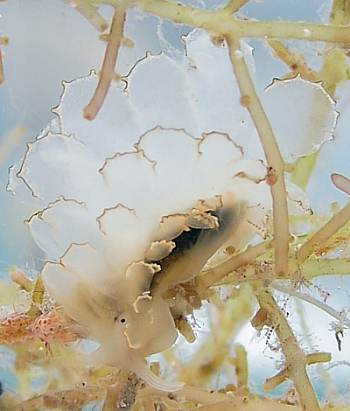
Cyerce graeca
Thompson, 1988
Order: SACOGLOSSA
Superfamily: LIMAPONTIOIDEA
Family: Caliphyllidae
DISTRIBUTION
Known only from Adriatic Sea [Croatia] and around the coast of Greece [Ionian Sea, Saronic Gulf].
PHOTO
Brac Island, Croatia. Size approx 1 cm. Photo: Jan Prochazka
The original description was based on 3 specimens colected in Greece. Thompson describes them as having a translucent white ground colour which was overlain dorsally by a pattern of dark brown which essentially covers the whole of the dorsum except for a patch on each side alongside the eyes, the head, infront of the rhinophores, and the tips of the rhinophores. Both the dorsal and ventral surfaces of the flattened cerata are translucent white, except for a 'row of blunt, dark brown digitations'. Thompson's largest specimen was 11mm long.
From the photo from Croatia, it seems the most distinctive feature of this species is the translucent white colouration of the cerata and the row of rounded papillae along the ceratal tip. The Croation specimen differs from Thompson's Greek specimens in having a brown line edging the tip of each ceras, rather than having brown tubercles.
Reference:
• Thompson, T.E. (1988) Eastern Mediterranean opisthobranchia: Oxynoidae, Polybranchiidae, Stiligeridae (Sacoglossa). Journal of Molluscan Studies, 54: 157-172.
Rudman, W.B., 2003 (October 7) Cyerce graeca Thompson, 1988. [In] Sea Slug Forum. Australian Museum, Sydney. Available from http://www.seaslugforum.net/find/cyergrae
Related messages
Re: Cyerce graeca from Croatia
October 15, 2003
From: Adam Petrusek
Dear Bill,
here is the additional information about the Cyerce graeca, supplied by Dr. Marcela Palkova who actually caught the specimen in the photo.
It was encountered at least three times near the bay approx 500 m east of the town Sumartin (southern part of Brac) in the depths between 25 and 30 m. The animals were always on the algae that grow on the hard substrate (on the open, not shaded bottom). So it seems the species is at least at this particular locality of the Adriatic sea well established.
Adam
petrusek@cesnet.cz
Petrusek, A., 2003 (Oct 15) Re: Cyerce graeca from Croatia. [Message in] Sea Slug Forum. Australian Museum, Sydney. Available from http://www.seaslugforum.net/find/11224Thanks Adam
Bill Rudman
Re: Cyerce graeca from Croatia
October 10, 2003
From: Adam Petrusek
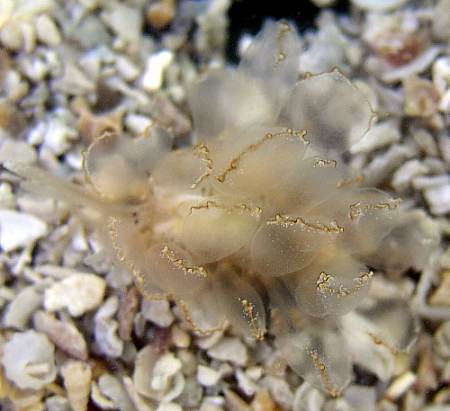
Dear Bill,
Thanks for the identification of Cyerce graeca.
Here are some more photos of this Croatian specimen of Cyerce graeca. Although there is nowhere in the photos where the dorsal part of the animal is really well visible (the cerata are somehow in the way...) I think we can be sure that it is dark pigmented. I will almost certainly manage to obtain more photographs in time, if there are more details to be seen, I will post them.
This specimen was caught by a diver during the Mediterranean Marine Fauna excursion of the Charles University in Prague (Czech Republic). The photos are taken in the aquarium. Date: September 7, 2003. Photographer: Martin Cerny. I will try to get more exact data about the locality, which was off Brac Island, Adriatic sea, Croatia.
I have one question regarding the taxonomy of Cyerce. I have found three different assignments to the family: HERMAEIDAE Adams H. & A., 1854; CALIPHYLLIDAE Thiele, 1912; POLYBRANCHIIDAE O'Donoghue, 1929.
How well are these families supported?
Bill, thank you very much, for your excellent and at least for us, very important work!
With regards
Adam Petrusek
petrusek@cesnet.cz
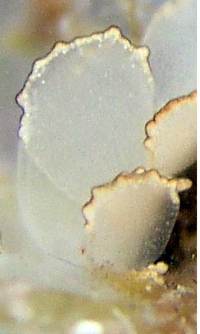
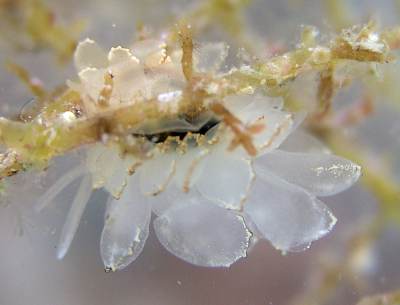
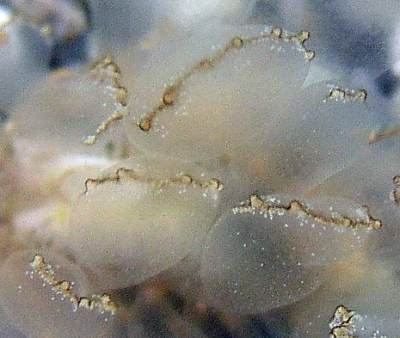
Dear Adam,
Thanks for these extra photos. I have included some close-ups to show the colour and shape of the cerata. The white specks are small glands, probably defensive. In this species they seem to form a band at the tip of each ceras. You can also see in the photo of the animal crawling upside down a pair of rhinophoral head tentacles. In this family the rhinophores are divided so there are in fact two on each side. In this case you can see the two right rhinophores.
Concerning a Family placement. There is been quite a few exhaustive studies on the sacoglossans over recent years and the relationships of genera and famileis are beginning to be somewhat more stabilisd than in the past. Without going in to great detail, of the 3 family names you mention here, 2 [Caliphyllidae, Polybranchiidae] are essentially a nomenclatural problem since both refer to the same evolutionary branch or clade, and the Hermaeidae represent a similar-looking but quite distinct clade. Present usage accepts the Caliphyllidae as the correct family name.
Best wishes
Bill Rudman
Cyerce graeca from Croatia
October 9, 2003
From: Adam Petrusek

Dear Bill,
When posting my earlier message I completely forgot about this beauty! Found near the island of Brac (Croatia). Size about 1 cm.
Photo: Jan Prochazka.
We have no clear idea about what it is. I would guess something related to Cyerce crystallina ...
Thanks for an ID!
Adam Petrusek
petrusek@cesnet.cz
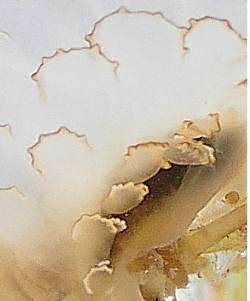
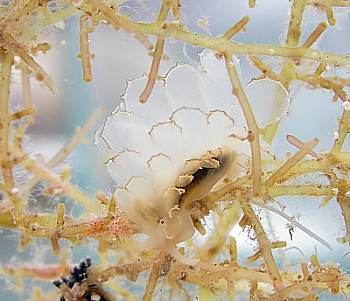
Dear Adam,
This is a wonderful find. I am sure this is Cyerce graeca, which as far as I know, has not been seen since it was originally described from Greece by Tom Thompson in 1988. I can't see the dorsal surface, which Thompson said was dark brown, but from the dark colouration on the side of the body below the cerata, it looks like this animal is similarly coloured. If you have any other photos which show part of the dorsal surface they would be a useful record. Also if you have fuller locality details, and a date, they would also be appreciated.
Best wishes
Bill Rudman
